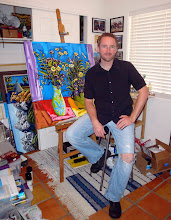
This week I have just finished a new canvas called "Sunset in the Catalinas", which depicts that moment when the light turns at a sharp angle on the hills and Saguaros - heralding the arrival of the end of the day. It is painted with dark contrasts much like many of my other works - and it is only one aspect of the feeling a sunset leaves on someone who is lucky enough to see it from Southern Arizona. There is another moment that comes after this kind of light - and in this other moment, just as the sun is about to set, the mountains and vegetation turn a near holographic pink. This only lasts for a few minutes, but it is something that I hope to capture one day. Then as the sun goes below the horizon we see the stripes of teal and orange and pink, the last and most beautiful moment as the stars emerge and the night comes.
Contrast is a great lesson in art. I am a believer in the power and the emotional range of contrast. One of those artists that taught me about this was the American photographer Ansel Adams. Adams worked nearly his entire life in the medium of black and white photography - however his images are so incredibly compelling, I have always felt that there are inherent lessons in them - even for a colorist like myself.
It has always seemed to me that Adams has the most spectacular sense of what is was that made a good picture. Never could you say that an Ansel Adams picture is devoid of content. Even if it is nothing but a huge sky with clouds, it is immediately apparent that Adams chose his subjects carefully - that the photographic print was complete, and full of the image that it sought to render. His tactic of darkening a sky deeply so that the objects on the foreground stood out in stronger contrast is quite amazing. Ansel seemed to understand that there were photos underneath the photos - something deeper and more beautiful that the object on the surface. I've heard it said that he would wait for hours until the light or the cloud formations of a landscape were just right, and then 'click', he made his photo.
Perhaps one needs to understand, as an artist, that no every single image that bombards the senses can be made into a lasting, eternal piece of art. Part of the act of having some kind of discretion is knowing what will not work - what image, photo or painting, does NOT constitute a compelling enough image to be memorable and unique. And of course, this is a personal process for most artists. I shoot photos that I paint my paintings from - and probably 85% of the photos shot out on location stand no chance whatsoever in becoming a Neil Myers painting. For me, the image must contain a full measure of content and feeling, and if it doesn't, it's just another snapshot. I would never want those random shots to become 'just another' painting.
One critic in the Ric Burns documentary on Ansel Adams stated that "There is something about Ansel's work which is almost Gothic". And I think that standard is a good one for an artist to hold themselves to. To the creation of work that is specific, emotional, undeniable and full of content and quality.
Ansel used to say "You know it's a good work of art if you remember it afterwards."
That is the goal we all strive for. The searing into our brains of a great work, of a true moment in time, or of a large and undeniably true image. So I can only hope that others remember my paintings the way I remember Ansel's photographs.
*All images are copyright Neil Myers 2007

No comments:
Post a Comment